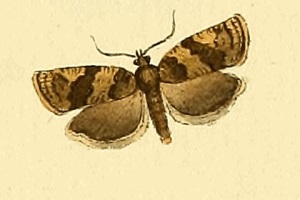
Spruce budworms and relatives are a group of closely related insects in the genus Choristoneura. Most are serious pests of conifers, such as spruce. There are nearly forty Choristoneura species, and even more subspecies, or forms, with a complexity of variation among populations found throughout much of the United States and Canada, and about again this number in Eurasia. In Eastern North America, Choristoneura fumiferana is prevalent, while in Western North America Choristoneura freemani has devastated large areas.

The Tortricidae are a family of moths, commonly known as tortrix moths or leafroller moths, in the order Lepidoptera. This large family has over 10,350 species described, and is the sole member of the superfamily Tortricoidea, although the genus Heliocosma is sometimes placed within this superfamily. Many of these are economically important pests. Olethreutidae is a junior synonym. The typical resting posture is with the wings folded back, producing a rather rounded profile.

Choristoneura fumiferana, the eastern spruce budworm, is a species of moth of the family Tortricidae. It is also commonly referred to as the spruce budworm. It is one of the most destructive native insects in the northern spruce and fir forests of the eastern United States and Canada. Its range is also the widest of all the budworm species. Eastern spruce budworm populations can experience significant oscillations. During outbreaks, populations grow to extremely high densities, compared to the relatively low levels that occur in between. These outbreaks are highly destructive and can cause both economic and ecological damage. As a result, methods of control are utilized. Several theories exist regarding these cyclical outbreaks: association with balsam fir maturation, catastrophe theory, dispersal from an epicenter, and oscillations synchronized by entrainment.

The Archipini are a tribe of tortrix moths. Since many genera of these are not yet assigned to tribes, the genus list presented here is provisional.

Choristoneura lambertiana, the sugar pine tortrix, is a moth of the family Tortricidae. It is found in the eastern parts of North America and the northern regions of the United States.

Choristoneura pinus, the jack pine budworm, is a moth of the family Tortricidae. It is found in jack pine forests in Canada from Atlantic provinces to Cypress Hills on the Alberta-Saskatchewan border as well as northern United States from New England to the lake states.

Archips semiferanus is a species of moth in the family Tortricidae, and one of several species of moth commonly known as oak leafroller or oak leaf roller. The larvae feed on the leaves of oak trees in the eastern United States and southeastern Canada and are a major defoliator of oak trees, which can lead to tree mortality. In Pennsylvania in the late 1960s and early 1970s, oak leafrollers defoliated over 1,045,000 acres (423,000 ha).

Choristoneura fractivittana, the broken-banded leafroller or dark-banded fireworm, is a moth of the family Tortricidae.
Choristoneura psoricodes is a species of moth of the family Tortricidae. It is found in South Africa.
Procrica pilgrima is a species of moth of the family Tortricidae. It is found in South Africa.
Choristoneura palladinoi is a species of moth of the family Tortricidae. It is found in Ethiopia.
Choristoneura africana is a species of moth of the family Tortricidae. It is found in Cameroon.
Choristoneura biennis, the two-year-cycle budworm moth, is a species of moth of the family Tortricidae. It is found in Canada, where it has been recorded from Alberta and British Columbia.
Choristoneura carnana is a species of moth of the family Tortricidae first described by William Barnes and August Busck in 1920. It is found in the United States, where it has been recorded from California and Colorado.

Choristoneura parallela, the parallel-banded leafroller moth, is a species of moth of the family Tortricidae. It is found in North America, where it has been recorded from California, Florida, Georgia, Indiana, Kentucky, Maine, Maryland, Michigan, Mississippi, New Jersey, North Carolina, Ohio, Oklahoma, Quebec, Saskatchewan, South Carolina, Tennessee, Virginia and West Virginia.
Choristoneura zapulata, the zapulata moth, is a species of moth of the family Tortricidae. It is found in North America, where it has been recorded from British Columbia to Quebec, south to California, Illinois and Pennsylvania.
Choristoneura argentifasciata is a species of moth of the family Tortricidae. It is found in the United States, where it has been recorded from Florida, Georgia, Louisiana, Mississippi and Texas.

Choristoneura diversana is a species of moth of the family Tortricidae. It is found in Great Britain, France, Belgium, the Netherlands, Germany, Denmark, Austria, Switzerland, Italy, the Czech Republic, Slovakia, Slovenia, Poland, Bulgaria, Hungary, Romania, Norway, Sweden, Finland, the Baltic region, Russia and the Near East. In the east, the range extends to China (Heilongjiang), Korea and Japan. The habitat consists of gardens, scrub and fens.
Choristoneura metasequoiacola is a species of moth of the family Tortricidae. It is found in Hubei, China.
Choristoneura improvisana is a species of moth of the family Tortricidae. It is found in Primorsky Krai in the Russian Far East. The habitat consists of bald mountain peaks and green moss-spruce forests.










